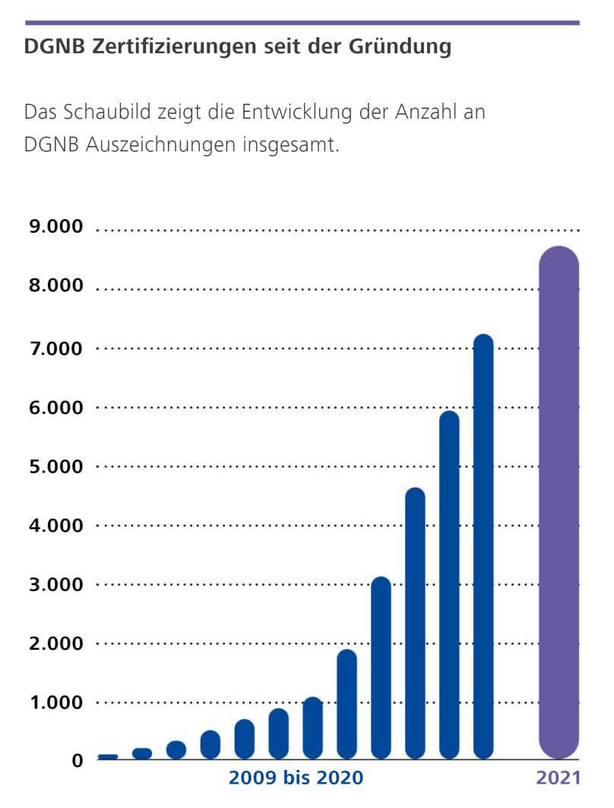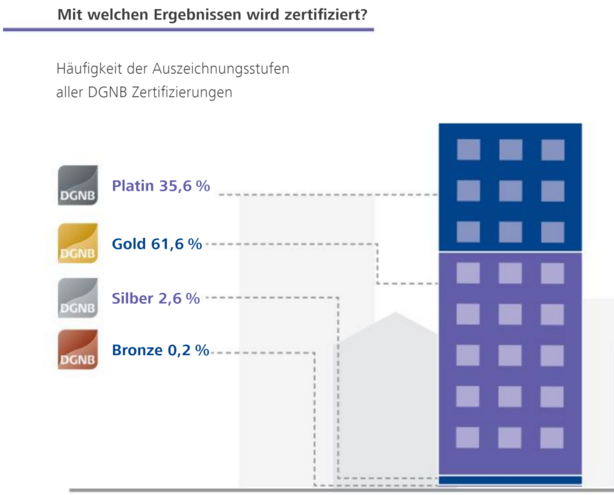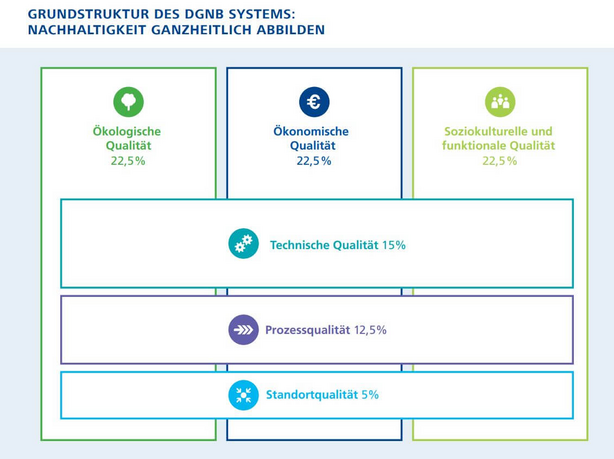- News
- Sustainability: Intrinsic motivation and legal obligation
Gold vs. Platinum certificate
Who still strives for Best-in-Class in the construction and real estate industry?
With the introduction of the EU Taxonomy at the start of the year, a fire has once again been it under concrete sustainability measures. Sustainability certificates will become mandatory by law in the future and are also indispensable in the transition phase. This is because financial investors are looking very closely at the future viability of their investment properties and these can be determined by sustainability criteria.


Building certification is booming
The DGNB (German Sustainable Building Council) is the leading institution for certification in Europe and has seen demand for its seals of approval increase every year for some time now.
In Germany there were 85.6% more applications for DGNB certification at the end of 2020 than in the previous year. Demand was comparatively lower in 2021 due to Covid, rising by 18%, but it is set to reach a record level in 2022 once again given the current prevailing focus on ESG. (Source Chart: DGNB Zertifizierungsreport 2021 by DGNB e.V. - Issuu S. 7)
Most frequently certified by building type are administrative and office buildings, for which over 730 certificates were awarded in 2021. In second place comes logistics and industrial buildings with 580 certificates and then the category with the fastest growth rate (+92%), namely buildings in operation. In 2021 there were just over 400 certificates here, closely followed by retail.
Comparing Gold and Platinum certificates
61.6% of the certificates are in the Gold category, while 35.6% of the construction projects certified opted for Platinum. In practice, Bronze and Silver are hardly a factor. (Source Chart: DGNB Zertifizierungsreport 2021 by DGNB e.V. - Issuu S. 8)
Certification auditors have enough to do, but the increasing demand is less euphoric than expected. After all, the question remains as to why almost two thirds of investors are satisfied with a Gold certificate instead of aiming for the highest certification class. For reference: Gold requires at least 65% of the total criteria to be met, for Platinum it is 80%. (Source Chart: 190502_DGNB_Systemflyer_A5_2019-deutsch.indd S. 4)

Is Gold “worse” than Platinum, “good enough” or “more than sufficient”?
In any case, achieving maximum performance in the properties awaiting certification is declining. The intrinsic motivation for Best-in-Class seems to have diminished due to the ever-increasing requirements of the respective criteria catalogues. By putting in the same level of effort as in the past, today it is only possible to achieve Gold rather than Platinum.

Certificates as a steering instrument for sustainability targets
Will minimum standards be enough to achieve the 2050 climate targets? Sadly, the answer is a clear no. The construction and real estate sector is responsible for 40% of CO2 emissions and bears an enormous responsibility to society. This means that consistent action is needed rather than compromises.
Why Gold certificates are preferred
So why is it that people prefer building projects to be certified according to the Gold system, and what incentives can be introduced so that companies go the extra mile for sustainable building?
We only have hypotheses about this, not definitive answers. The main purpose of this article is to stimulate a discussion in our industry. Because the implementation and further development of sustainability measures is – more than ever before – a joint undertaking.
Marketing & image benefits that come with Gold certification are sufficient
80% of companies that decide to certify their property see certification as an important marketing tool, one which at the same time objectively evaluates the efforts towards sustainability. Certificates highlight the economic benefits of sustainable action and progress made on climate issues. However, if a Gold certificate is enough to serve as a quality guarantee and differentiator, the added value of Platinum should be evaluated accordingly and better communicated to companies.
Greater outlay for Platinum
For example: For Platinum certification, the auditor should be involved at a very early planning stage in order to be able to consider any possible points from the course of the process. For Gold, the certification process can also be started during the ongoing implementation of the project. In the case of Platinum, the specifications for materials are stricter and can lead to higher construction costs in the short term. However, in the case of Gold certification, late action and necessary changes can result in much higher costs. Early cooperation with auditors ensures a stable, sustainability-oriented project implementation and is the best basis for a Platinum certificate.
One size does not fit all
Nevertheless, the individual certification classes all have their merits and investors should decide for themselves which system is suitable for their project. A knowledge transfer for follow-up projects could be an important incentive to develop a construction project with experts that deploys best practice right from the start.
Sources:
DGNB (2018): Sustainable building, design and operation
DGNB (2020): Buiding for a better world
DGNB (2021): EU Taxonomy Study